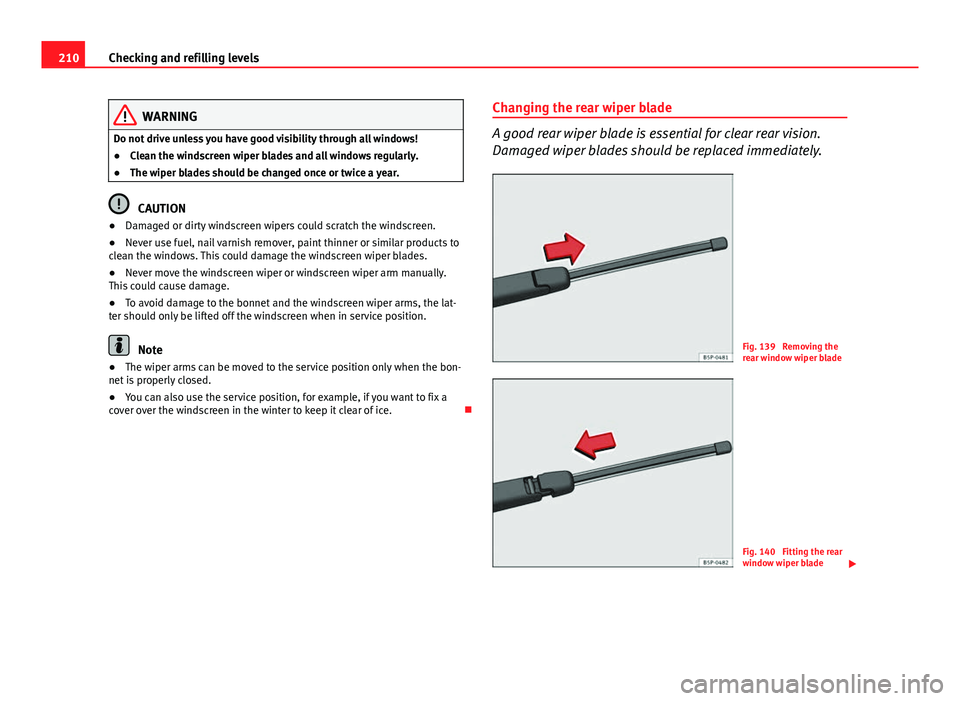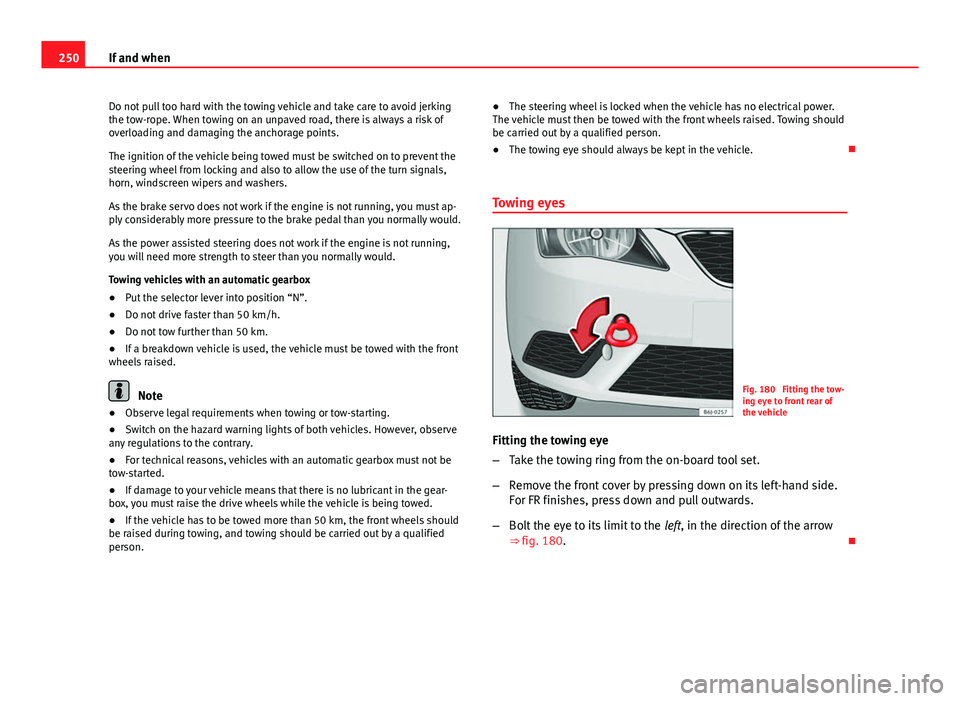Page 212 of 280

210Checking and refilling levels
WARNING
Do not drive unless you have good visibility through all windows!
● Clean the windscreen wiper blades and all windows regularly.
● The wiper blades should be changed once or twice a year.
CAUTION
● Damaged or dirty windscreen wipers could scratch the windscreen.
● Never use fuel, nail varnish remover, paint thinner or similar products to
clean the windows. This could damage the windscreen wiper blades.
● Never move the windscreen wiper or windscreen wiper arm manually.
This could cause damage.
● To avoid damage to the bonnet and the windscreen wiper arms, the lat-
ter should only be lifted off the windscreen when in service position.
Note
● The wiper arms can be moved to the service position only when the bon-
net is properly closed.
● You can also use the service position, for example, if you want to fix a
cover over the windscreen in the winter to keep it clear of ice. Changing the rear wiper blade
A good rear wiper blade is essential for clear rear vision.
Damaged wiper blades should be replaced immediately.
Fig. 139 Removing the
rear window wiper blade
Fig. 140 Fitting the rear
window wiper blade
Page 233 of 280

231
If and when
NumberConsumerAmps36Main beam headlight, right10, 15 c)37Main beam headlight, left10, 15c)38Engine heater3039Vacant 4012 Volt Input/Cigarette lighter1541Heated seats control unit / Cup Holder2542Horn2043Panorama sunroof3044Windscreen wipers2045Heated rear window30
46Radio / Bluetooth / USB + AUX-In / DC-DC con-
verter for Start-Stop20
47Climatronic / autoclima / Gateway / Diagnosis /
Automatic gearbox (ZSS lock)5
48Locking unit2549Electric windows (front)2550Rear electric windows3051Automatic gearbox control unit2552Alarm15
53Electro-kinetic pump relay/bi-turbo fuel control
unit15
54Reverse light for automatic gearbox/ Fog light /
Cornering light15
55Transformer on15, 20b)56Rear window wiper1057Dipped beam headlights (right side) / Daylight1558Dipped beam headlights (to the left) / Daylight15a)
If it is LPG.
b) Ampere rating according to motorisation.
c) If it has Start-Stop or not. Fuses below steering wheel in relay holder
PTC fuses
NumberConsumerAmps1Supplementary electrical heating using air402Supplementary electrical heating using air403Supplementary electrical heating using air40
AUX 1 Fuses
NumberConsumerAmps
1Left daytime light AFS lamp15, 20
a)Navigator, Bluetooth, MDI, radio control lever20
2Right daytime light AFS lamp15, 20a)Instrument panel / ESP relay53Headlight washer pump20a)
If it has Start-Stop or not.
AUX 3 Fuses
NumberConsumerAmps1Trailer control unit152Trailer control unit203Trailer control unit20
Safety FirstOperating InstructionsPractical TipsTechnical Specifications
Page 252 of 280

250If and when
Do not pull too hard with the towing vehicle and take care to avoid jerking
the tow-rope. When towing on an unpaved road, there is always a risk of
overloading and damaging the anchorage points.
The ignition of the vehicle being towed must be switched on to prevent the
steering wheel from locking and also to allow the use of the turn signals,
horn, windscreen wipers and washers.
As the brake servo does not work if the engine is not running, you must ap-
ply considerably more pressure to the brake pedal than you normally would.
As the power assisted steering does not work if the engine is not running,
you will need more strength to steer than you normally would.
Towing vehicles with an automatic gearbox
● Put the selector lever into position “N”.
● Do not drive faster than 50 km/h.
● Do not tow further than 50 km.
● If a breakdown vehicle is used, the vehicle must be towed with the front
wheels raised.
Note
● Observe legal requirements when towing or tow-starting.
● Switch on the hazard warning lights of both vehicles. However, observe
any regulations to the contrary.
● For technical reasons, vehicles with an automatic gearbox must not be
tow-started.
● If damage to your vehicle means that there is no lubricant in the gear-
box, you must raise the drive wheels while the vehicle is being towed.
● If the vehicle has to be towed more than 50 km, the front wheels should
be raised during towing, and towing should be carried out by a qualified
person. ●
The steering wheel is locked when the vehicle has no electrical power.
The vehicle must then be towed with the front wheels raised. Towing should
be carried out by a qualified person.
● The towing eye should always be kept in the vehicle.
Towing eyesFig. 180 Fitting the tow-
ing eye to front rear of
the vehicle
Fitting the towing eye
– Take the towing ring from the on-board tool set.
– Remove the front cover by pressing down on its left-hand side.
For FR finishes, press down and pull outwards.
– Bolt the eye to its limit to the left, in the direction of the arrow
⇒ fig. 180.
Page 278 of 280

V
Vehicle battery . . . . . . . . . . . . . . . . . . . . . . . . . 213
Vehicle data . . . . . . . . . . . . . . . . . . . . . . . . . . . 253
Vehicle identification data . . . . . . . . . . . . . . . . 253
Vehicle identification number . . . . . . . . . . . . . 253
Vehicle interior heating or cooling system . . . 136
Vehicle modifications . . . . . . . . . . . . . . . . . . . 189
Vehicle paintwork Maintenance . . . . . . . . . . . . . . . . . . . . . . . . 183
Products for vehicle maintenance . . . . . . . 180
Vehicle tools Storage . . . . . . . . . . . . . . . . . . . . . . . . . . . . 221
Vehicle washing . . . . . . . . . . . . . . . . . . . . . . . . 181
Ventilation . . . . . . . . . . . . . . . . . . . . . . . . . . . . 133
Ventilation slits . . . . . . . . . . . . . . . . . . . . . . . . . 17
W
Warning lamp . . . . . . . . . . . . . . . . . . . . . . . . . . . 31
Warning lamps . . . . . . . . . . . . . . . . . . . . . . . . . . 63
Warning reports Red . . . . . . . . . . . . . . . . . . . . . . . . . . . . . . . . 66
Yellow . . . . . . . . . . . . . . . . . . . . . . . . . . . . . . 66
Warning symbols . . . . . . . . . . . . . . . . . . . . . . . . 66
Warning triangle . . . . . . . . . . . . . . . . . . . . . . . . 126
Washer fluid . . . . . . . . . . . . . . . . . . . . . . . . . . . 208
Washing by hand . . . . . . . . . . . . . . . . . . . . . . . 181
Washing the vehicle . . . . . . . . . . . . . . . . . . . . . 181
Washing tunnel . . . . . . . . . . . . . . . . . . . . . . . . 181
Washing with high pressure cleaners . . . . . . . 182
Water in the windscreen washer tank . . . . . . . 208 Wear indicators . . . . . . . . . . . . . . . . . . . . . . . . 217
Wearing suitable shoes . . . . . . . . . . . . . . . . . . . 16
Wheel bolts . . . . . . . . . . . . . . . . . . . . . . . . 224, 255
Tightening torque . . . . . . . . . . . . . . . . . . . . 219
Wheel change . . . . . . . . . . . . . . . . . . . . . . . . . . 222
Wheels . . . . . . . . . . . . . . . . . . . . . . . . . . . 215, 255
Why assume the correct sitting position? . . . . . 30
Why should head restraints be correctly adjus- ted? . . . . . . . . . . . . . . . . . . . . . . . . . . . . . . . . . 13
Why wear seat belts? . . . . . . . . . . . . . . . 19, 21, 30
Windows . . . . . . . . . . . . . . . . . . . . . . . . . . . . . . . 92
Windscreen defrosting . . . . . . . . . . . . . . . . . . . 133
Windscreen washer fluid Warning lamp . . . . . . . . . . . . . . . . . . . . . . . . 69
Windscreen wiper blades Cleaning . . . . . . . . . . . . . . . . . . . . . . . . . . . 184
Windscreen wipers . . . . . . . . . . . . . . . . . . . . . . 106 Changing blades . . . . . . . . . . . . . . . . . . . . 209
Changing the rear wiper blade . . . . . . . . . 210
Winter driving Diesel engine . . . . . . . . . . . . . . . . . . . . . . . 199
Winter tyres . . . . . . . . . . . . . . . . . . . . . . . . . . . . 219
Wooden trim cleaning . . . . . . . . . . . . . . . . . . . 187
Working in the engine compartment . . . . . . . 199
276 Index